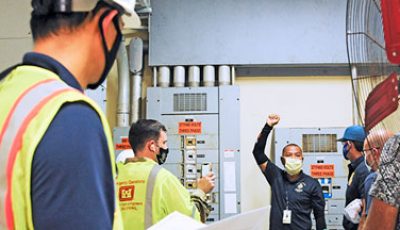USACE urged to ‘do the right thing’ on former hospital dump
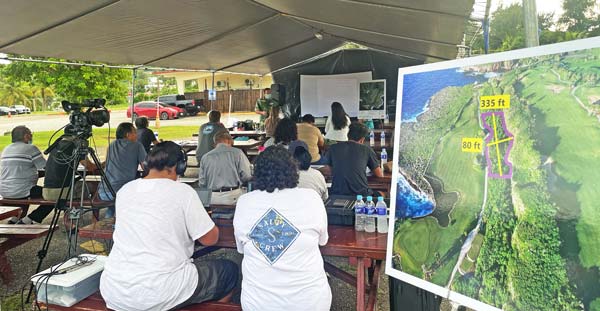
A map of the former Talafofo hospital dump site is on display at the public information meeting organized by the U.S. Army Corps of Engineers last week at the Legislature’s parking lot on Capital Hill. (IVA MAURIN)
Do you know of any site in the CNMI that might have been complicated by the presence—even potential or perceived—of a hazardous substance? Do you know of any possible formerly-used defense sites that could be investigated, and cleaned up?
These popped up at the public information meeting held last week on Capital Hill, organized by the U.S. Army Corps of Engineers, regarding the findings and proposed actions on the dump site of what used to be back in June 1945, a 2,000-bed surgical hospital in Talafofo.
The proposed plan of the USACE is to take no further action. The public has until the end of this month, on Sept. 30, Thursday, to comment on this plan—if they are for or against it.
During the meeting last week, the USACE, through project manager Scott Moncrief, presented the results of several investigations that were performed at the site, where, accordingly, several metals in the soil where found, including arsenic, barium, cadmium, chromium, lead, mercury, selenium, and silver.
The 2011 report stated that heavy metals arsenic, chromium, lead, mercury, and silver exceeded the Pacific Basin environmental screening levels, and were referred to as “contaminants of potential concern.”
According to the World Health Organization, small amounts of water-soluble barium and lead cause kidney damage and increased risk of high blood pressure, among others. Cadmium is classified as a carcinogen, along with chromium. Mercury is associated with neurological and behavioral disorders. Long-term exposure to arsenic from drinking water and food can cause cancer and skin lesions. It is also linked to diabetes and cardiovascular disease.
The USACE completed its Remedial Investigation report in October 2020 as a follow-up, which stated that, except for arsenic, the metals found in the site soil did not exceed the Tropical Pacific Environmental Screening Levels. On arsenic, they said that “the 95% upper confidence limit was less than the site-specific background value.”
It was then concluded that the metals in the soil do not pose an “unacceptable risk” to human health, and that “potential risk to ecological receptors from exposure to the metals reduced to an acceptable level.” The USACE’s recommendation? “No Action for chemical contamination in site soil.”
The “No Action” recommendation basically means that there will be no additional investigation or remediation on the site.
‘Please do the right thing’
Compared to the public information meeting last June at the Hyatt Regency Saipan, more community members participated in the meeting last Sept. 1 at the Legislature’s parking lot on Capital Hill.
Many, if not all, expressed concern and rallied behind the need for further investigations on the site, as well as on many other possible former defense dump sites on island.
Former Tanapag Action Group president Juan Tenorio called on USACE to “do the right thing,” and urged it to dig deeper beyond 12 inches, stressing that the chemicals harm agriculture, and are all health hazards affecting pregnant women and the unborn child.
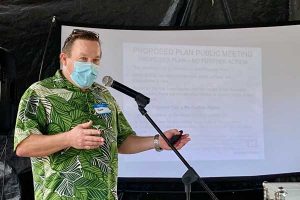
Project manager Scott Moncrief presents the “No further action” recommendation of the U.S. Army Corps of Engineers on the Talafofo Hospital dump site, now Kingfisher Golf Course, at the public information meeting last week at the Legislature’s parking lot on Capital Hill. (IVA MAURIN)
“What you’re telling us now—that is exactly what the federal government told me back in 1982. I got some samples already sent to Australia and Japan. When they came back, we found that they were lying, and they ended up spending $46 million cleaning Tanapag,” Tenorio said. “They brought in CDC [U.S. Centers for Disease Control] to do an entire physical health checkup in Tanapag, and we’re not done. So here you are, telling us that after 77 years, nothing’s [going to] happen? I disagree with you, sir.”
Tenorio was referring to the fuel farm on the Tanapag Settlement, and the ceramic capacitors the U.S. Forces brought to the island that contained oil saturated with PCB [polychlorinated biphenyls], a toxic chemical that causes cancer, the production of which was banned in the United States in the ’70s.
“Please, please do the right thing,” Tenorio said. “All of these chemicals are health hazards, so don’t have the audacity to come and tell us that these will not cause any or pose any health problem. Please, we are not as dumb as people think we are.”
Moncrief assured that the USACE took no shortcuts in investigating the Talafofo dump site, and that they did not see anything that would have led to PCB contamination. “We followed the scientific, best methodology for implementing the study, and we did adhere to very, very high quality controls when we planned the study, and when we sent the samples to the laboratory. We didn’t cut corners. These results are representative of the conditions at the site.”
Moncrief also clarified that their presentation is focused on the former Talafofo hospital dump site, and not the other sites on the island.
Reporting formerly-used defense sites
Not far from the former hospital dump is another site where drum cans appear to just have been pushed in, according to Fred Camacho, another community member present at the USACE-organized meeting.
Camacho also said the drums happen to be on their property, and expressed concern that, given that the hospital is “right next door,” the site might have been used as another dump.
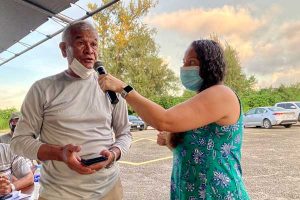
Former Tanapag Action Group president Juan Tenorio calls on the U.S. Army Corps of Engineers to do the right thing, adding that the chemicals found at the former hospital dump are all health hazards and are harmful to agriculture. The USACE report stated that the metals in the soil do not pose an “unacceptable risk” to human health. (IVA MAURIN)
He also added that that it is his understanding that there has been a lot of bulldozing that happened in the golf course, that the Talafofo dump site is not the only site that was used as a dumpster, and that a lot of “stuff” were just pushed over the cliff.
“We’re concentrating on this site. Yes, you have sample sites within the golf course area but…there are a few military dumpsites on island that haven’t been looked at. I don’t know how you’re going to go about finding out where all the debris are,” he added.
In response, Moncrief informed the community that information laid out by Camacho could be responded to by the Bureau of Environmental and Coastal Quality.
BECQ’s Division of Environmental Quality has a Storage Tanks, Site Assessment and Remediation branch that ensures the assessment and cleanup of sites contaminated by hazardous substances, through the Brownfields Program of the U.S. Environmental Protection Agency and the FUDS program of the USACE.
“If there is some way to identify that there’s an addition to the FUDS program, there’s also an EPA Brownfields Program that can address things that are not captured in the FUDS Program. EPA provides money for investigations and cleanup of those sites,” Moncrief said.
Moncrief also added that in addition to military dumps, there were also municipal dumps around the island that had a mixture of military and municipal waste, which are potential Brownfield sites and possibly FUD sites.
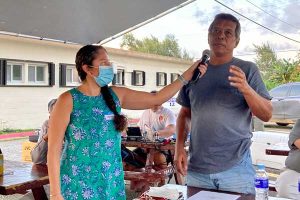
Community member Fred Camacho talks about drums located not far from the former Talafofo hospital dump site, suggesting that the site may have also been used as another dump. Camacho’s comment led to other community members talking about the many other possible locations on island that could be hazardous, including the very parking lot where the meeting was being held, and the now Department of Finance Building on Capital Hill. (IVA MAURIN)
“The CNMI Bureau of Environmental and Coastal Quality would be a good place to start with that. They have boots on the ground here. They could go out if somebody sees debris that might be wartime area debris, and they can help identify that and bring that to the attention of EPA or Army Corps, or both,” he said.
USEPA defines Brownfield land as a property where its expansion, redevelopment, or reuse may be complicated by the presence (or potential presence) of hazardous materials. These can be abandoned gas stations, dry cleaning establishments, factories, mills, or foundries; or at a smaller scale, can be dry cleaners, vacant lots, or gas stations.
Acting DEQ director Robert B. Deleon Guerrero said at the meeting that the program is not just limited to Saipan, but extends to Tinian and Rota, and that there is a process involved—which includes coordinating with the land owners—once the site is deemed eligible for the Brownfield or FUDS programs.
“Currently under the Storage Tanks program, we are working on closing a legacy underground storage tank [site] which was in Puerto Rico. It was formerly known as the former WWII service station,” he said.
Deleon Guerrero said they are also looking for sites that were used as service stations, and for anyone who may have information to reach out to BECQ so the sites can be discussed and investigated.
For any information regarding Brownfields and FUDS sites, contact BECQ’s Storage Tanks, Site Assessment & Remediation (ST/AR) Branch at 664-8534 or 664-8506.



